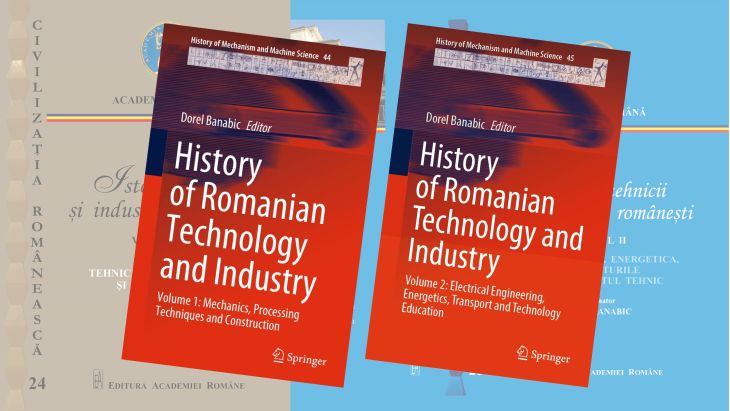The prestigious Springer publishing house published at the end of 2023 two large volumes on the history of Romanian technology and industry. Through a platform with excellent visibility and reputation, the book gives a global audience access to the most comprehensive synthesis of the achievements of Romanian engineering and industry. Specifically, we are talking about the English version of the “History of Romanian Technology and Industry” coordinated by Dorel Banabic and published by the Romanian Academy Publishing House in 2019 (volume 1 – in RO) and 2020 (volume 2 – in RO).
Dorel Banabic notes in the introduction to the English version that historians, industrialists, engineers, and sociologists have all studied the history of technology in Romania in the past. However, there are only a few examples when a multidisciplinary perspective is taken. The book published in two volumes by Springer – Volume 1 “Mechanics, Processing Techniques and Construction” and Volume 2 “Electrical Engineering, Energetics, Transport and Technology Education” – proposes this approach and divides “the field of technology into multiple industrial branches, such as mining, metallurgy, oil, natural gas, machine building, agricultural machinery, military, textiles, construction, electrical engineering, energetics, biomedicine, naval transport, railway, automotive, and aviation, but also folk technology, the forming of the industrial system, mechanics, inventions, technological societies, or the history of technological education”. More than 50 authors have contributed to this work, which aims above all to respond to a problem: the history of Romanian technology is scarcely known outside the borders of Romania. “This is due, among other reasons, to the insufficient popularisation in widely spoken languages of the history of Romanian technology and the main Romanian contributions to the world’s technological heritage”, Dorel Banabic notes. “For each field, we engaged the collaboration of top specialists or authors who have already published a history of their field. Certain chapters were drafted with the aid of specialists who have played the role of policymakers in the elaboration of development strategies for Romania and who are familiar not only with the facts and the history of their field but also with the ‘philosophy’ behind its development. Such is the case of the chapters on the history of machine building, the history of electrical engineering, the history of energetics, and the history of oil. Making the most of these ‘living archives’ adds to the quality of the present book”, writes the editor of the “History… “.
The central aim of the work is „to contribute to promoting the valuable achievements of Romanian technology both at home and abroad (through its English edition)”, concludes Dorel Banabic.
Energy occupies an important space in the first volume, with extensive chapters dedicated to mining (author: Dumitru Fodor), metallurgy (Iulian Ripoșan, Stelian Stan), oil industry (Gheorghe Buliga), natural gas industry (Dumitru Chisăliță). The second volume opens with a chapter dedicated to the history of energetics (Victor Vaida, Viorel Bădescu), and unfortunately does not include the history of electrical engineering (Florin Tănăsescu, Ion Boldea), from the Romanian edition. It ends with a text signed by coordinator Dorel Banabic and dedicated to the outstanding personalities of Romanian engineering — 70 names not to be forgotten. The introduction to the English edition also includes some solutions for increasing the visibility of Romanian technological achievements, such as: „publishing a history of Romanian technology and industry on the website of the Romanian Academy and on that of the Academy of Technical Sciences of Romania; having Romanian specialists participate more frequently in conferences on the history of technology; introducing information on Romanian engineers into the English version of Wikipedia”.
The release of the English version of Dorel Banabic’s work also has the advantage of drawing Romanians’ attention to notable figures and accomplishments in their country’s history of technology and industry.

